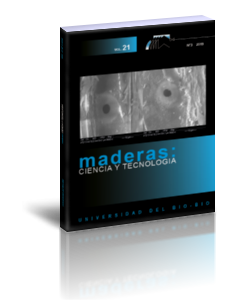Characterization of pacific silver fir impregnated with extractives from western redcedar
Keywords:
Dimensional stability, durability, extractives, impregnation, Western redcedarAbstract
Alternative and higher value uses are needed for residual materials generated from wood products processing. Western redcedar sawdust contains an array of unique chemicals and has the potential to be used to alter the appearance, stability and durability of non-durable timbers. Here it was hypothesized that impregnation of Western redcedar heartwood extractives into Pacific silver fir would decrease shrinkage, hygroscopicity, and susceptibility to decay. Western redcedar hot water extracts were obtained from sawdust and used to pressure-treat Pacific silver fir blocks. Extractive impregnation enhanced the wood’s appearance and gave it a more cedar-like brown colour. Impregnated samples had reduced shrinkage, but were not as dimensionally stable as Western redcedar heartwood. Pacific silver fir blocks impregnated with water-soluble extractives were also highly susceptible to leaching, and leached samples had similar shrinkage values to untreated controls. In contrast, leaching had little effect on the hygroscopicity of the Western redcedar heartwood. Extractive-impregnated Pacific silver fir blocks had increased resistance to decay by two brown-rot fungi, and showed resistance similar to that of Western redcedar heartwood. However, leached blocks did not have the same decay resistance.
Downloads
References
American Wood Protection Association. AWPA. 2016. Laboratory method for evaluating the decay resistance of wood-based materials against pure basidiomycete cultures: soil/block test. Standard E10-16. American Wood Protection Association: Birmingham, AL. 12p.
American Wood Protection Association. AWPA. 2016. Standard method for accelerated evaluation of preservative leaching. Standard E11-16. American Wood Protection Association: Birmingham, AL . 3p.
Clausen, C.A.; Yang, V. 2007. Protecting wood from mould, decay, and termites with multi-component biocide systems. International Biodeterioration & Biodegradation 59(1):20-24.
Daniels, C.R., Russell, J.H. 2007. Analysis of western redcedar (Thuja plicata Donn) heartwood components by HPLC as a possible screening tool for trees with enhanced natural durability. Journal of Chromatographic Science 45(5): 281-285.
Diouf, P.N.; Del Barre, N.; Perrin, D.; Gerardin, P.; Rapin, C.; Jacquot, J.P. Gelhaye, E. 2002. Influence of tropolone on Poria placenta wood degradation. Applied and Environmental Microbiology 68(9):4377-4382.
Ermeydan, M.A.; Cabane, E.; Masic, A.; Koetz, J.; Burgert, I. 2012. Flavonoid insertion into cell walls improves wood properties. ACS Applied Materials & Interfaces 4(11):5782-5789.
Glass, S.V.; Zelinka, S.L. 2010. Moisture relations and physical properties of wood. In Wood handbook-Wood as an engineering material. General Technical Report FPL-GTR-190. Madison, WI: U.S. Department of Agriculture, Forest Service, Forest Products Laboratory. 508 p.
Gonzalez, J.S. 2004. Growth, properties and uses of western red cedar (Thuja plicata Donn ex D. Don.). Special Publication-Forintek Canada Corporation: Canada SP-37R.
Hart, J.H. 1989. The role of wood exudates and extractives in protecting wood from decay. In Natural Products of Woody Plants. Springer: Berlin Heidelberg. pp. 861-880.
Johansson, C.I.; Saddler, J.N.; Beatson, R.P. 2000. Characterization of the polyphenolics related to the colour of western red cedar (Thuja plicata Donn) heartwood. Holzforschung 54(3):246-254.
Kai, Y.; Swan, E.P. 1990. Chemical constituents contributing to the color of western red cedar heartwood. Mokuzai Gakkaishi 36(3):218-224.
Kirker, G.T.; Blodgett, A.B.; Lebow, S.; Clausen, C.A. 2013. Transferable Durability: Enhancing decay resistance of non-durable species with extractives from durable wood species. Int Res Group Wood Protection: Stockholm, Sweden. Document No. IRG/WP/13-10808. 12p.
Li, S.; Freitag, C.M.; Morrell, J.J.; Okabe, T. 2012. Antifungal effects of hinokitiol and its sodium salt for wood protection. BioResources 7(4):5312-5318.
Macdonald, B.F.; Maclean, H. 1965. Effect of high temperature on the durability of western red cedar. Canadian Forest Industries 85(3):93.
Morris, P.I. 1995. Pacific silver fir is the more-treatable component of hem-fir from coastal British Columbia. Forest Products Journal 45(9):37-40.
Rudman, P. 1962. The causes of natural durability in t-40imber. IX. The antifungal activity of heartwood extractives in a wood substrate. Holzforschung 16(3):74-77.
Sakai, K.; Matsunaga, M.; Minato, K.; Nakatsubo, F. 1999. Effects of impregnation of simple phenolic and natural polycyclic compounds on physical properties of wood. J Wood Science 45(3):227-232.
Shi, J.; Avramidis, S. 2018. Dried cell wall nanopore configuration of Douglas-fir, western red cedar and aspen heartwoods. Wood Sci Technol 52(4):1025-1037.
Silviera, A.G.; Santini, E.J.; Kulczyski, S.M.; Trevisan, R.; Wastowski, A.D.; Gatto, D.A. 2017. Tannic extract potential as natural wood preservative of Acacia mearnsii. An Acad Bras Ciênc 89(4):3031-3038.
Southam, C.M.; Ehrlich, J. 1943. Effects of extract of western red-cedar heartwood on certain wood-decaying fungi in culture. Phytopathology 33:517-524.
Stirling, R.; Morris, P.I. 2006. The influence of extractives on western red cedar’s equilibrium moisture content. Int Res Group Wood Protection: Stockholm Sweden. Document No. IRG/WP/06-403311. 2p.
Stirling, R.; Morris, P.I. 2016. Potential contributions of lignans to decay resistance in western red cedar. Wood Sci Technol 50(2):399-412.
Stirling, R.; Sturrock, R.N.; Baybrooks, A. 2017. Fungal decay of western redcedar wood products-a review. International Biodeterioration & Biodegradation 125:105-115.
Taylor, A.M.; Gartner, B.L.; Morrell, J.J. 2002. Heartwood formation and natural durability-a review. Wood Fiber Sci 34(4):587-611.
Turner, P.; Conradie, D. 1995. The chemical analysis and biological evaluation of wood extractives as potential timber preservatives. Int Res Group Wood Protection: Stockholm, Sweden. Document No. IRG/WP/95-30090. 9p.
Wangaard, F.F.; Granados, L.A. 1967. The effect of extractives on water-vapor sorption by wood. Wood Sci Technol 1(4):253-277.
Yamamoto, K.; Hong, L.T. 1988. Decay resistance of extractives from chengal (Neobalanocarpus heimii). Journal of Tropical Forest Science 1(1):51-55.
Yano, H. 1994. The changes in the acoustic properties of Western Red Cedar due to methanol extraction. Holzforschung 48(6):491-495.

































